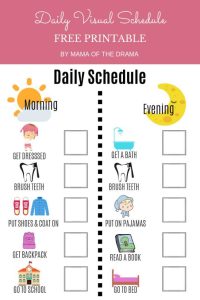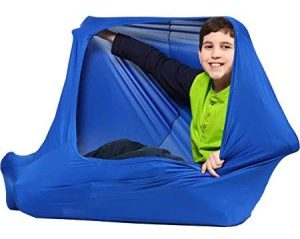Is your child more active than usual? Is his/her attention or focus hard to maintain? The start of a new school year can be a chaotic and stressful time for both kids and parents. This is especially true for kids with sensory processing challenges, as changes are difficult and can be hard to manage.
To support this transitional time and help makes things easier on the family, here are some fun sensory tips and ideas for back-to-school time.
1. Visual Schedules
Try to incorporate structure and routine into daily life as much as possible. Having a solid routine supports a child’s ability to anticipate what is to come, assisting in task-follow through and completion. A visual schedule is easy to create and helps a child understand what the plans and expectations are for each day. Your child may enjoy helping to make the schedule each day, as it can help him/her feel a sense of control.

2. Provide the Right Types of Sensory Input
Most children benefit from movement and muscle work activities, which support an organized and regulated state of arousal. This leads to increased times of focus, attention and emotional regulation to help meet environmental, social and academic demands throughout the school day.
Have your child complete simple sensory tasks before the school day begins, such as jumping, spinning, dancing or completing animal walks around the house such as crab or bear walks or have a fidget or soft toy to hold onto while in the car.
Talk to your child’s teacher and/or therapist about incorporating sensory alerting or calming breaks into the classroom schedule to support a calm and focused state for your child. An occupational therapist can suggest additional sensory ideas for the home setting with a specific program tailored to your child.
3. Add Deep Pressure During the Day
For calming input throughout the school day, pack your child’s backpack with a weighted stuffed animal or several of their favorite (heavy) books. This added deep-pressure input can support calming and help keep them more regulated, especially during transition times throughout the day. A water bottle with a resistive suck or chewable top is also helpful for sensory regulation and is appropriate for all ages.

4. Stay Focused on Homework
To support timely homework completion, reward small work intervals with praise and follow up with an immediate incentive when all work is completed. Make sure all instructions are very specific to reduce frustration and misunderstandings.
5. Transition to Bedtime
End your child’s day with calming techniques to lower their overall energy level, leading to a good night’s sleep for the next school day. Active children often need intense, repetitive physical activity before bed to satisfy their need for movement. Some children may surprisingly benefit from this type of activity before settling down for sleep. Deep pressure, massages over the arms and legs, the use of weighted blankets, a spandex sheet over the mattress, slow rocking and decreased auditory input can help settle a child better for sleep.

Author/Information provided by: Kelli Arnone MOT, OTR/L, SIPT
Kelli Arnone is the Co-owner and Director of Pediatric Potentials, Inc. a private sensory processing therapy clinic in Lake Mary, Florida. Kelli has over 25 years of experience working with children with sensory integration challenges as well as other developmental delays. She has worked in numerous hospitals, schools, community programs and private practices. She is trained and certified to administer the Sensory Integration Praxis Test (SIPT) and is also trained and certified in Therapeutic Listening, Handwriting Without Tears, The Wilbarger Deep Pressure Protocol and is an Advanced Trained Neurofeedback Practitioner.
